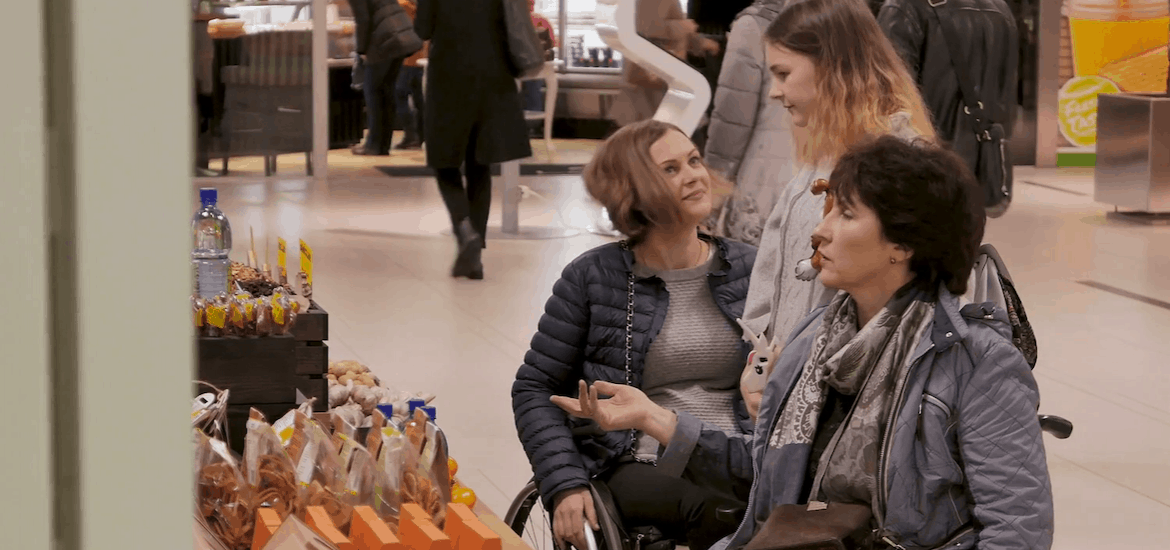Occasionally, when out and about on my power chair, I notice that well-meaning able-bodied people are confused about how to help and when to help me. I applaud your willingness to help and urge you to keep on being helpful!
Here are some ideas that might help you help those who are in wheelchairs to feel as respected as anyone else who comes across your path.
1. Door opening.

If you are on the opposite side of the door, that is; you are inside, and the wheelchair user is outside, motion to the person, asking if they would like your help. If they motion yes, move through the door to their side of the door, then step behind the door and pull it toward you. The wheelchair user now has plenty of space to pass through the door without the risk of running over your toes. NEVER reach across the threshold and swing the door, expecting the wheelchair user to drive under or beside your outstretched arm. Not only is this dangerous for both of you but it violates the wheelchair user’s personal space.
Believe the wheelchair user!! They know their abilities and weaknesses better than you do. Although their methodology might appear awkward to a casual bystander at times, the wheelchair owner knows how to handle their chair. They know how much space they need to manoeuvre their chair through doorways and up curbs. If they decline your help and say “I got it, thanks”, it is wise to take that statement at face value. If you step in to help them as they are midway through a door, you could actually make things worse. I once had to choose between running over someone’s toes and steering toward a window. I chose the window, and in the process, broke it. People said I should have run over the guy’s toes, but he was only trying to help.
2. Cars vs Wheelchairs
Wheelchair users are pedestrians. This includes powerchairs, scooters and manual wheelchairs. In North America, pedestrians usually have the right of way. However, wise wheelchair users are cautious due to too many near misses. They will try to make eye contact with you before proceeding at unmarked intersections. If they sense a driver is not paying attention to traffic, they will try to make eye contact at marked intersections as well. No, they aren’t nervous or slow. They are wise.
Wheelchair users must use the cutaway curbs and sloped corners at intersections. Please don’t block the curb when you are trying to turn right into traffic, and then honk your horn at the wheelchair users when they don’t cross in front of you. A wise wheelchair user will not begin to cross an intersection if their view of the pedestrian section of an intersection is obstructed.
Before turning right or left, please look to the right AND the left to make sure that a pedestrian isn’t trying to cross the street in front of you. It seems like common sense, but I have had several close calls when a driver has driven right across a sidewalk from an alleyway without first checking for pedestrian traffic. Powered wheelchairs and scooters cannot stop on a dime, just like a car cannot stop on a dime.
2. Personal space.
Never lean against or reach over a wheelchair. Never play with any of the buttons of a power wheelchair without first asking permission. Most wheelchair users look at their wheelchairs as an extension of their bodies. If you wouldn’t clasp a stranger’s shoulder when you talk with them, don’t clasp the handle of a wheelchair when talking with a stranger in a wheelchair.
3. Respect
If an able-bodied person and a wheelchair user are travelling together, do not assume the able-bodied person is the official spokesperson for the wheelchair user. If you are a server, directly address each member of the party as individuals, regardless if one of your guests has a disability or not. If a person is unable to verbally respond, and they do not use a talking board or use another form of communication, only then look to their companions for help.
Ask the wheelchair user how to best serve them. If you are a sales clerk, ask the wheelchair user where they would like you to place their shopping bags. Most chair users have a bag strapped on the back of their chair. If your customer/client had a hard time pulling out their charge card or debit card, they probably will have a hard time placing that card back in their wallet. The same goes for cash. Please be patient with the transaction. It saves you the hassle of having to come around and pick up the spilt change or card and it saves your customer the inconvenience of having to gather spilt change.
When engaged in an extended conversation with someone in a wheelchair, pull up a chair unless you are trying to make a statement that you have more power in the conversational dynamic. You will both be more comfortable. If you choose to crouch beside their chair, ask permission first before using the arm of their wheelchair to steady yourself. Remember, their chair is considered part of their personal space.
Adults are adults. Unless you would use cute endearments when addressing able-bodied people, never use them when addressing a wheelchair user: dearie, honey, sweetie.
Do you have other tips? Let me know!
Katherine Walden

